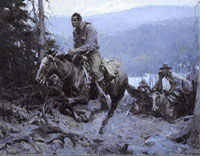
A Slate piece about Bush not always getting the intelligence reports he 'wants':
According to The Bush Tragedy, a new book by Slate's Jacob Weisberg, Bush suffers from a similar inability to distinguish between what he wants to see and what is there to be seen. This is nicely captured in an anecdote about a painting (that's itto the left ofabove this text; click to enlarge) that Bush put up in his office when he was governor of Texas. Weisberg writes:
In an April 1995 memo, Bush invited his staff to come to his office to look at a painting. … The picture is a Western scene of a cowboy riding up a craggy hill, with two other riders following behind him. Bush told visitors—who often noted his resemblance to the rider in front—that it was called A Charge To Keep and that it was based on his favorite Methodist hymn of that title, written in the eighteenth century by Charles Wesley. As Bush noted in the memo, which he quoted in his autobiography of the same title: "I thought I would share with you a recent bit of Texas history which epitomizes our mission. When you come into my office, please take a look at the beautiful painting of a horseman determinedly charging up what appears to be a steep and rough trail. This is us. What adds complete life to the painting for me is the message of Charles Wesley that we serve One greater than ourselves." Bush identified with the lead rider, whom he took to be a kind of Christian cowboy, an embodiment of indomitable vigor, courage, and moral clarity.
Bush subsequently took the painting to Washington, hung it in the Oval Office, and continued to tell the painting's inspiring story, adding embellishments:
He came to believe that the picture depicted the circuit-riders who spread Methodism across the Alleghenies in the nineteenth century. In other words, the cowboy who looked like Bush was a missionary of his own denomination.
Only that is not the title, message, or meaning of the painting. The artist, W.H.D. Koerner, executed it to illustrate a Western short story entitled "The Slipper Tongue," published in The Saturday Evening Post in 1916. The story is about a smooth-talking horse thief who is caught, and then escapes a lynch mob in the Sand Hills of Nebraska. The illustration depicts the thief fleeing his captors. In the magazine, the illustration bears the caption: "Had His Start Been Fifteen Minutes Longer He Would Not Have Been Caught."
I'm glad Bush mis-identifies himself with the rider. He got the 'horse thief' part metaphorically right. In the interest of sport, I recommend he get a short head start. One step. Get a rope.
*"There are none so blind as those who will not see. The most deluded people are those who choose to ignore what they already know. The proverb has been traced back in English to 1546 (John Heywood), and resembles the Biblical verse quoted (above). In 1738, it was used by Jonathan Swift in his 'Polite Conversation,' and is first attested in the United States in the 1713 'Works of Thomas Chalkley'..."
No comments:
Post a Comment